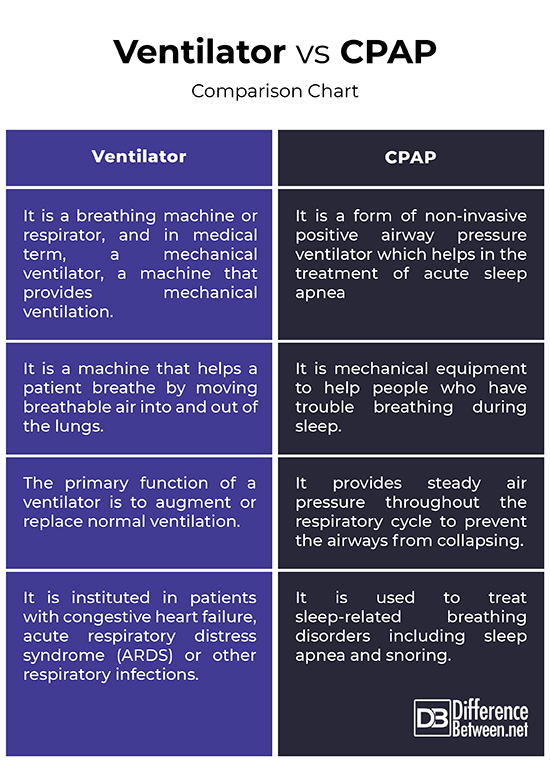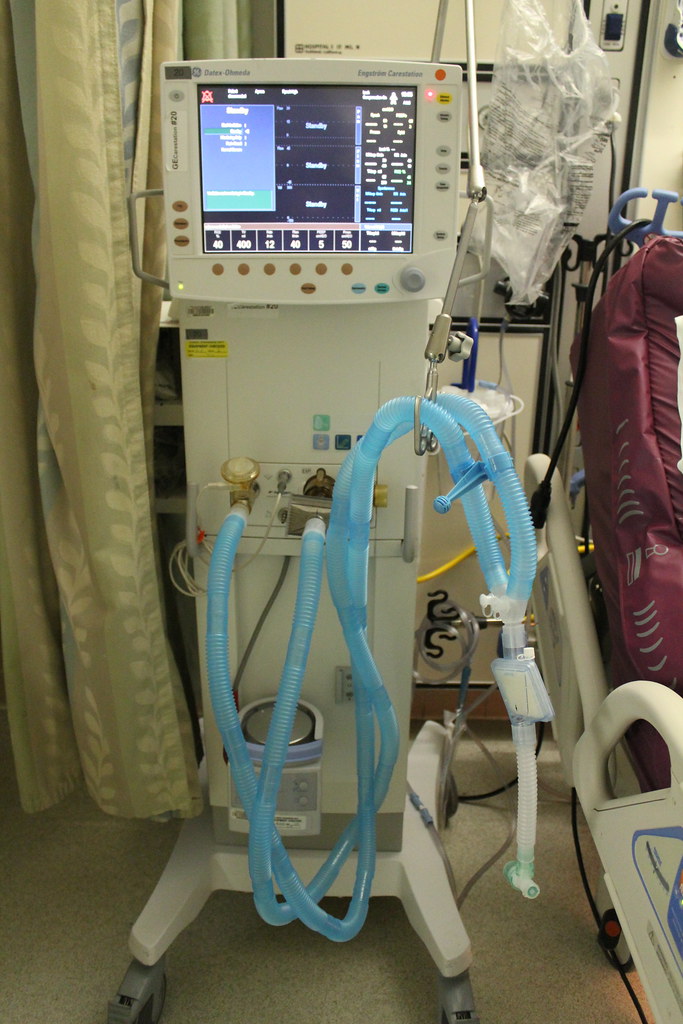Difference Between Ventilator and CPAP
Ventilator and CPAP both are machines designed to administer mechanical ventilation in patients with breathing disorders. Mechanical ventilation is the most commonly used mode of life support in medicine today. Ventilators are an essential respiratory care function provisioned to patients suffering from respiratory failure. CPAP, short for Continuous Positive Airway Pressure, as the name suggests, is a machine that administers mechanical ventilation for patients who are spontaneously breathing by providing a continuous pressurized air supply into their airways.
Ventilator
Ventilator is a machine that helps a patient breathe by moving breathable air into and out of the lungs. It is often referred to as a breathing machine or respirator, and in medical term, it is called a ‘mechanical ventilator’ – a machine that provides mechanical ventilation. It is kind of a life support machine that delivers breathable air into a patient who is unable to breathe or breathe insufficiently which might be caused by a variety of conditions such as sleep apnea, acute ventilatory failure, impending ventilatory failure, and severe oxygenation problems. The primary function of a ventilator is to augment or replace normal ventilation with mechanical ventilation. Mechanical ventilation is primarily a form of supportive care and does not treat the underlying illness. Mechanical ventilation can be either controlled mechanical ventilation (CMV) or assisted mechanical ventilation (AMV).

Continuous Positive Airway Pressure (CPAP)
CPAP, short for Continuous Positive Airway Pressure, is a type of positive airway pressure ventilator which helps in the treatment for obstructive sleep apnea. It is mechanical equipment to help people who have trouble breathing during sleep. CPAP is usually administered by means of a ventilator which allows continuous monitoring of the delivered pressure. It is a non-invasive life support machine that uses a hose and mask or nosepiece to deliver constant and steady flow of air into your airway. It increases the air pressure in your throat to prevent your airway from collapsing during sleep and allow you to breathe normally. This limits both hypoxic episodes and snoring, and the patient no longer feels permanently exhausted. CPAP is less invasive than mechanical ventilation and causes less barotraumas. It decreases the frequency of obstructive and mixed apneic spells in some infants.
Difference between Ventilator and CPAP
Basics
– Both ventilators and CPAPs are life-support machines that provide mechanical ventilation to help patients with breathing disorders. Ventilators are mechanical equipment used to augment or replace normal ventilation in patients who have trouble breathing on their own which might be caused by a variety of conditions. CPAP, on the other hand, is a form of non-invasive positive airway pressure ventilator which helps in the treatment of acute sleep apnea and is administered by means of a ventilator which allows continuous monitoring of the delivered pressure.
Function
– Mechanical ventilation is primarily a form of supportive care and does not treat the underlying illness. A ventilator pumps oxygen into the lungs and removes carbon dioxide through a tube, taking over the body’s breathing process when some condition or illness has caused lung failure. The primary function of a ventilator is to augment or replace normal ventilation. CPAP is mechanical equipment to help people who have trouble breathing during sleep. It provides continuous air pressure throughout the respiratory cycle to prevent the airways from collapsing when you inhale and blows the same pressure when you exhale.
Working
– Mechanical ventilation is instituted simply to maintain the patient’s normal breathing capacity. Ventilator is mechanical breathing equipment designed to move air into and out of the lungs through a breathing tube, one end of which goes through patient’s mouth into the windpipe while the other end is attached to the ventilator. The ventilator blows air, or air with increased oxygen, through the tubes into the patient’s airways. CPAP, on the other hand, uses a hose and mask or nosepiece to deliver constant and steady flow of air into the patient’s airway. It gently pumps ambient air, under pressure via a flow generator through the hose and into the mask, which provides a steady flow of pressurized air through the nose.
Clinical Applications
– Ventilators are life-support machines mostly used in emergency care and intensive care to treat patients with congestive heart failure or acute respiratory distress syndrome (ARDS) or other respiratory infections like influenza, pneumonia, and COVID-19. Mechanical ventilation is instituted in patients with breathing problems which can be accompanied by a variety of conditions such as sleep apnea, acute ventilatory failure, impending ventilatory failure, and severe oxygenation problems. CPAP, on the other hand, is a great alternative to mechanical ventilation used to treat sleep-related breathing disorders including sleep apnea.
Ventilator vs. CPAP: Comparison Chart

Summary of Ventilator vs. CPAP
Mechanical ventilation is primarily a form of supportive care and does not treat the underlying illness. It supports two very important physiologic goals: to normalize arterial blood gas and acid-base imbalance by providing adequate ventilation and to decrease the patient’s work of breathing by moving air into and out of the patient’s lungs in a synchronous manner. A CPAP machine, on the other hand, can be used in patients who are suffering from obstructive sleep apnea (OSA). There are certain guidelines and protocols to be followed for when CPAP should be instituted. It is generally administered in patients who are in moderate to severe respiratory distress.
- Difference Between Caucus and Primary - June 18, 2024
- Difference Between PPO and POS - May 30, 2024
- Difference Between RFID and NFC - May 28, 2024
Search DifferenceBetween.net :
Leave a Response
References :
[0]Lachmann, B. et al. Mechanical Ventilation: Clinical Applications and Pathophysiology. Amsterdam, Netherlands: Elsevier Health Sciences, 2007. Print
[1]Shelledy, David C. and Jay I. Peters. Mechanical Ventilation. Burlington, Massachusetts: Jones & Bartlett Learning, 2019. Print
[2]Cairo, J.M.. Pilbeam's Mechanical Ventilation: Physiological and Clinical Applications. Amsterdam, Netherlands: Elsevier Health Sciences, 2013. Print
[3]Sumner, Charlotte J., et al. Spinal Muscular Atrophy: Disease Mechanisms and Therapy. Cambridge, Massachusetts: Academic Press, 2016. Print
[4]Image credit: https://es.wikipedia.org/wiki/Archivo:Cpap-example.jpg
[5]Image credit: https://live.staticflickr.com/5146/5646118244_fbb898a22c_b.jpg

